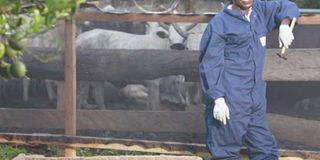Livestock farmers benefit from new disease control tool from Icipe

A farmer stands next to his zero-grazing unit which is surrounded with the livestock protective fence (LPF). The new disease control tool from Icipe has helped dairy farmers enhance milk production and mastitis control. PHOTO | STELLAR MURUMBA | NATION MEDIA GROUP
What you need to know:
- The livestock protective fence (LPF) has been developed by the International Centre for Insect Physiology and Ecology (Icipe).
- The efficiency of smallholder dairy cows in Kenya is inhibited by numerous animal diseases like mastitis, helminthosis and tick-borne diseases.
- Dr Rajinder Kumar Saini, says the livestock production systems target the development of animal health packages for the rural poor in Kenya.
- The Chairman of Nawiri Dairy Farmers Co-operative Society, Robert Nyakundi called on the government to expand the project.
The efficiency of smallholder dairy cows in Kenya is inhibited by numerous animal diseases namely mastitis, helminthosis, tick-borne diseases and in some cases the tsetse fly transmitted trypanosomiasis.
Cows, particularly in zero-grazing units, attract biting and non-biting flies which cause agitation, spread of diseases and contribute to unhygienic conditions.
In some areas tsetse flies are attracted to zero-grazing units.
In the long run, there is evident weight loss leading to dwindling productivity in dairy cows.
However, this is going to be a thing of the past after the introduction of the livestock protective fence (LPF) by International Centre for Insect Physiology and Ecology (Icipe).

The livestock protective fence (LPF) has been tested through pilot projects, funded by the International Fund for Agriculture Development (IFAD) in Kisii and Bungoma. PHOTO | STELLAR MURUMBA | NATION MEDIA GROUP
ENHANCE MILK PRODUCTION
According to researchers, the LPF is a major component of an innovative site specific animal health package for zero-grazing units meant for enhancing milk production and mastitis control.
Icipe’s principal scientist and programme leader, Dr Rajinder Kumar Saini, says the livestock production systems target the development of animal health packages for the rural poor in Kenya.
Dr Saini states that the LPF has been proven to be an important tool for the control of animal disease constraints leading to improved livestock productivity, improved food security and poverty alleviation.
The LPF, he says, has been tested through pilot projects, funded by the International Fund for Agriculture Development (IFAD) in Kisii and Bungoma.
Researchers engaged in the pilot projects noted that milk off-take has steadily improved from 20 per cent in 2012 to 60 per cent in 2013 in the project sites.
The increase was recorded for both LPF protected cow pens and pit waste protected units. Also, an increase in milk off-take of 40 per cent was recorded in semi-grazing units.

Mary Aendo, 53, at her dairy farm in Nyakoe Village, Kisii County during a field tour by Icipe officials and other major stakeholders. PHOTO | STELLAR MURUMBA | NATION MEDIA GROUP
HOW LPF WORKS
“Flies are attracted to animal odour in pens and LPF which is an insecticide-treated screen attached to the pen perimeter.
“Flies do not see open mash so they land on the net and are killed by insecticide in the fibres on the screen.
“It has been scientifically proven that flies travel at low levels of about 1.5 meters and will land on the LPF, pick up the insecticide (deltamethrin) and die within 24 hours.
“A 10-20 seconds exposure of the flies to LPF is enough to kill them,” says Dr Saini.
He adds that the LPF is currently being supplied by Vestergaard, a global company innovating game-changing solutions that contribute to a healthier, more sustainable planet.
Most farmers in the study areas reported perceive a decrease in malaria cases as the stomoxys, housefly and mosquito numbers were also greatly reduced.
In this study, Dr Saini states, a reduction in the number of stomoxys was followed by a reduction in mastitis cases.
REDUCED MALRIA CASES
“Fewer cases of malaria per household per year were reported. This is evident through household questionnaires.
Reduction in mosquito numbers and correspondingly reduction in malaria cases being reported indicate that the LPFs have the potential to impact human health,” he says.
According to Mary Oendo, 53, a dairy farmer from Nyakoe village, Kisii County, her cows were not productive prior to her embracing the LPF from Icipe.
Mrs Oendo states that mastitis was a major issue to her dairy cows and the biting flies never gave her piece while milking.
“I used to milk two litres of milk per cow those days because my cows were restless because of flies.
“But after Icipe team did a diagnosis and later installed the LPF, I have never been happier.
CONTROLLED FLIES
"Now I milk at least 10 litres per cow and at the end of the month I pocket around Sh20,000 as the LPF has greatly controlled biting and non-biting flies from disturbing my cows during milking,” says Mrs Oendo.
She added that the post-intervention by Icipe has resulted to cost savings in the treatment of malaria infections and in the reduction of mastitis infections.
The Chairman of Nawiri Dairy Farmers Co-operative Society, Robert Nyakundi called on the government to expand the project.
“We have reported not only an increase in milk production but also this region boasts of high quality milk in the county.
“We therefore urge the government to partner with Icipe and be on the frontline in improving the quality of life of dairy farmers,” says Mr Nyakundi.
However, Dr Saini says the project is not a silver bullet but the actuality of the net has been proved and is not a matter of debate.





